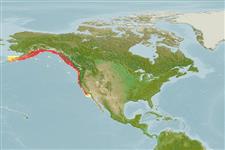>
Perciformes/Scorpaenoidei (Scorpionfishes) >
Sebastidae (Rockfishes, rockcods and thornyheads) > Sebastinae
Etymology: Sebastes: Greek, sebastes = august, venerable (Ref. 45335); flavidus: From the Latin flavidus, meaning 'yellow' (Ref. 27436).
More on author: Ayres.
Environment: milieu / climate zone / depth range / distribution range
Ecologia
marino associati a barriera corallina; distribuzione batimetrica 0 - 549 m (Ref. 6793), usually 24 - 46 m (Ref. 2850). Temperate; 62°N - 32°N, 167°W - 117°W
Northeast Pacific: Unalaska Island, Alaska to San Diego, California, USA.
Length at first maturity / Size / Peso / Age
Maturity: Lm 36.0, range 27 - 42 cm
Max length : 66.0 cm TL maschio/sesso non determinato; (Ref. 4925); peso massimo pubblicato: 2.5 kg (Ref. 40637); Età massima riportata: 64 anni (Ref. 39247)
Short description
Chiavi di identificazione | Morfologia | Morfometria
Spine dorsali (totale) : 13; Raggi dorsali molli (totale) : 14 - 16; Spine anali: 3; Raggi anali molli: 7 - 9. Head spines weak - nasals present, preocular and parietal spines usually absent, supraocular, postocular, tympanic, coronal and nuchal spines absent (Ref. 27437). May have a prominent symphyseal knob; posterior edge of anal fin vertical (Ref. 27436). Caudal fin nearly truncate but slightly forked (Ref. 6885). Olive green to greenish brown with some light mottling dorsally, light ventrally; fins yellowish green, ventral fins often tinged in orange (Ref. 27436).
Form schools in open water along steeply sloping shores or above rocky reefs; also holes up amid cracks and crevices of the sea floor (Ref. 27436). Juveniles found around floats and pilings (Ref. 27436). Feed on pelagic crustaceans, fishes and squids (Ref. 6885). Viviparous (Ref. 34817). Filleted, then sold fresh or frozen, with other rockfishes (Ref. 27436).
Clemens, W.A. and G.V. Wilby, 1961. Fishes of the Pacific coast of Canada. 2nd ed. Fish. Res. Bd. Canada Bull. (68):443 p. (Ref. 4925)
IUCN Red List Status (Ref. 130435: Version 2024-1)
Threat to humans
Harmless
Human uses
Pesca: commerciale; Pesce da pesca sportiva: si; Acquario: Acquari pubblici
Strumenti
Special reports
Download XML
Fonti Internet
Estimates based on models
Preferred temperature (Ref.
123201): 4.2 - 11.4, mean 7.5 °C (based on 44 cells).
Phylogenetic diversity index (Ref.
82804): PD
50 = 0.5000 [Uniqueness, from 0.5 = low to 2.0 = high].
Bayesian length-weight: a=0.01000 (0.00495 - 0.02022), b=3.09 (2.92 - 3.26), in cm total length, based on LWR estimates for this Genus-body shape (Ref.
93245).
Trophic level (Ref.
69278): 4.2 ±0.6 se; based on diet studies.
Resilienza (Ref.
120179): Basso, tempo minimo di raddoppiamento della popolazione 4.5 - 14 anni (K=0.16; tm=6-7; tmax=64).
Prior r = 0.26, 95% CL = 0.17 - 0.40, Based on 1 full stock assessment.
Fishing Vulnerability (Ref.
59153): High vulnerability (56 of 100).
Climate Vulnerability (Ref.
125649): Low to moderate vulnerability (28 of 100).
Nutrients (Ref.
124155): Calcium = 6.46 [2.45, 19.19] mg/100g; Iron = 0.123 [0.048, 0.292] mg/100g; Protein = 19 [18, 20] %; Omega3 = 0.815 [0.305, 2.162] g/100g; Selenium = 28.4 [10.2, 86.7] μg/100g; VitaminA = 74.9 [24.9, 241.2] μg/100g; Zinc = 0.301 [0.155, 0.544] mg/100g (wet weight); based on
nutrient studies.
